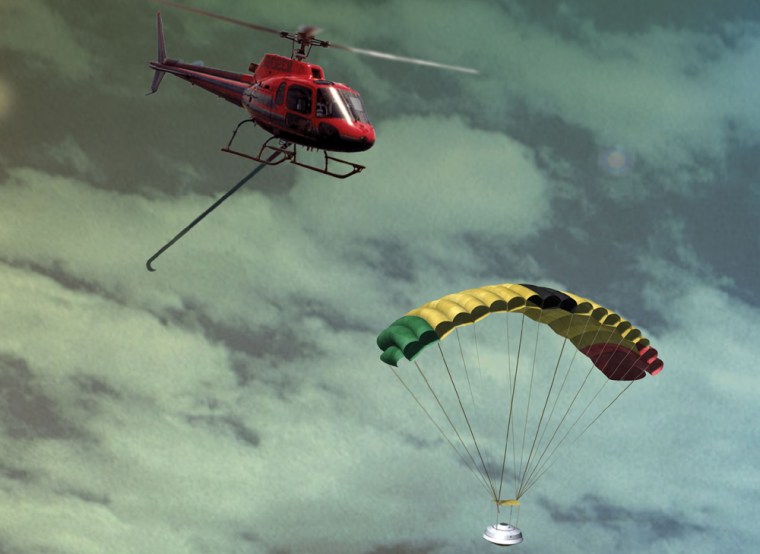A team of NASA scientists, navigators and helicopter stunt pilots is ready to snatch a space sample canister out of the sky next month when the Genesis spacecraft returns to Earth.
After more than two years collecting solar wind particles streaming from the sun, Genesis will hurl its sample return capsule at the Utah desert on Sept. 8, where a pair of helicopter crews expect to snag it in midair.
"[Genesis] will help us understand the composition of the sun, which makes up 99 percent of the solar system," David Lindstrom, Genesis program scientist at NASA Headquarters, said during a press briefing Thursday. "We're excited … [but] the real excitement for a scientist begins when we get these samples back to our labs."
Launched in 2001, Genesis has spent the last three years outside Earth's magnetic field to sample solar wind particles for study on Earth. Five collector panels were open to the solar wind for 27 months before folding into a sample return capsule last April for the trip back to Earth.
The sample canister will be retrieved above the U.S. Air Force Utah Test and Training Range, which sits in the Great Salt Lake desert about 70 miles (112 kilometers) west of Salt Lake City. Genesis marks NASA's first attempt to return extraterrestrial space samples since the Apollo 17 crew hauled home rocks from the moon in 1972.
Genesis comes home
Genesis has already begun steering for home, with its last course change leaving it almost 1 million miles (1.3 million kilometers) from Earth. Two more course adjustments are expected to aim the spacecraft at its Utah target.
"Right now we're traveling about 600 miles an hour," George Carlisle, NASA's navigation chief for Genesis, said during the briefing. "When we enter Earth's atmosphere, we'll traveling between 3,000 and 4,600 miles an hour."
Carlisle said the Genesis spacecraft is designed to start spinning at about 8 a.m. ET on Sept. 8, then release its sample return capsule toward the Utah testing range. At noon ET, the capsule should smack into Earth's atmosphere 85 miles (135 kilometers) above Salem, Ore., and reach Utah airspace 96 seconds later.
A drogue chute will slow the capsule to subsonic speeds, where the main parachute is expected to deploy. Two waiting helicopters flown by Hollywood stunt pilots should then swoop up to the capsule and catch its parachute with a hook and pole about 4,000 feet (1,200 meters) above the Utah desert.
"We kind of agreed that out of a scale of one to 10, this is between an eight and nine," Dan Rudert, a capture pilot with South Coast Helicopter in Santa Ana, Calif., said of the sample retrieval maneuver.
100 percent success
Genesis midair retrieval operations chief Roy Haggard, of Vertigo Inc. in California, told reporters his team already has performed 11 simulated Genesis captures with a 100 percent success rate.
But first, Genesis has to reach Earth.
In 10 days the spacecraft should execute a course adjustment setting on a Utah-bound path. About 52 hours before it arrives, mission managers will have one more chance to make final tweaks in the spacecraft's approach to Earth. There is also a fall back plan if an anomaly pops up prior to three hours before capsule separation.
"There's another opportunity for reentry in six months," Carlisle said. "At any point, if anything goes wrong, we can punch the button and bail out and take the six-month backup. "
